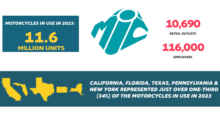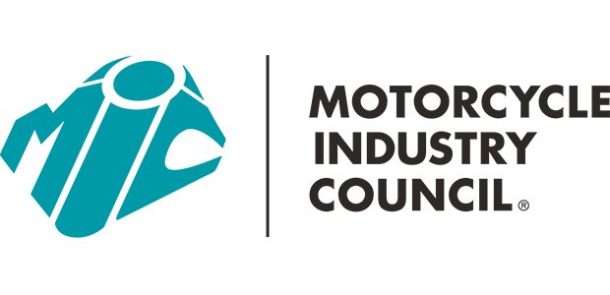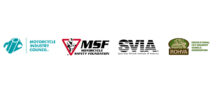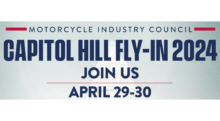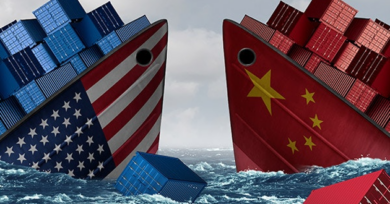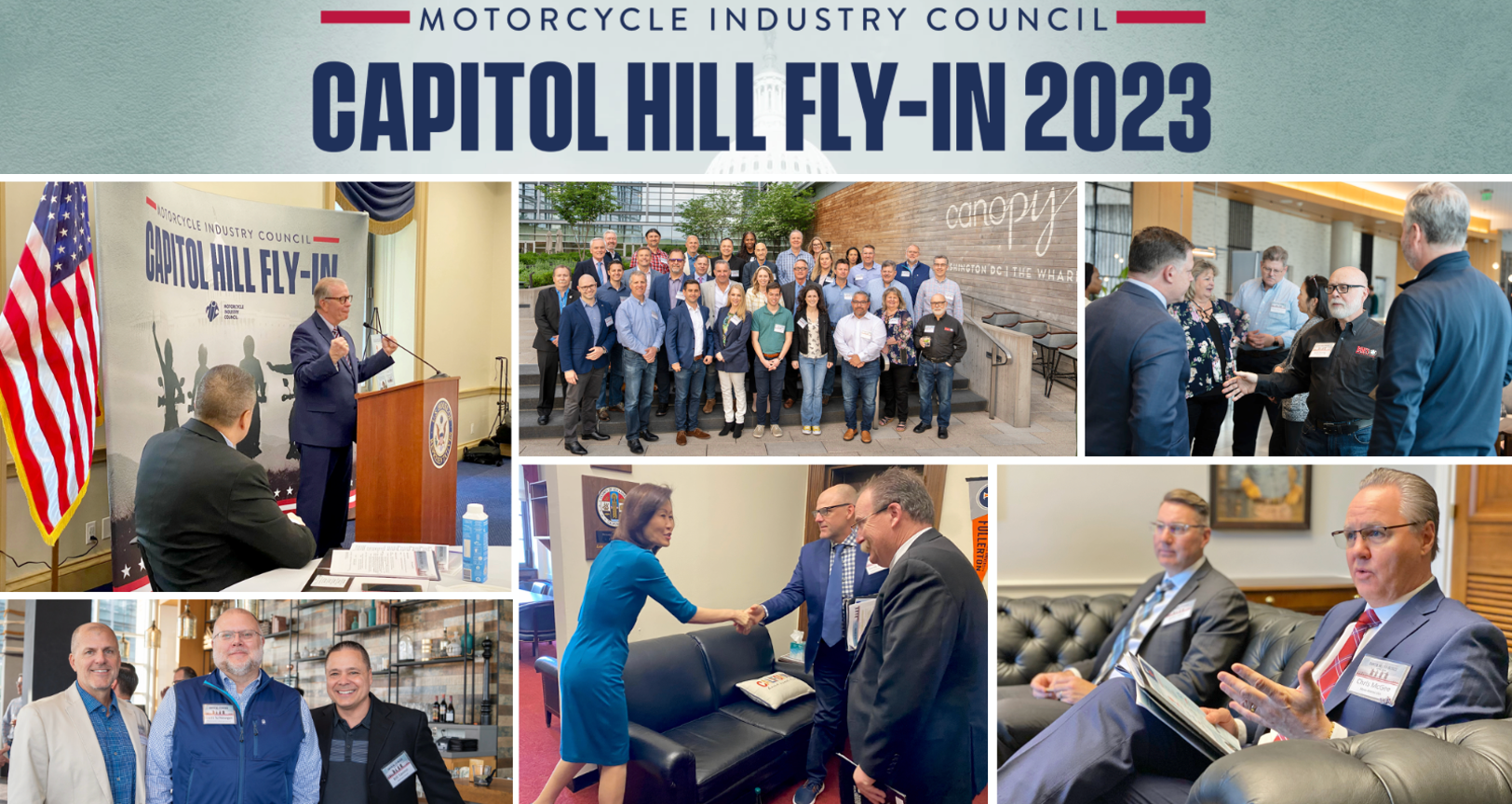MIC discusses industry with new chair and vice chair
The MIC has released the April Symposium online, featuring a wide-ranging conversation with MIC Chair Derek Brooks and Vice Chair John Hinz. The discussion was moderated by Joey Lindahl, a member of the association’s board of directors. Brooks is the motorcycle product line manager for Yamaha Motor Corporation, U.S.A, John Hinz is the CEO of KTM North America, Inc. and Lindahl is the marketing director for Slingshot, Polaris Inc.
Watch the entire Symposium video or check out highlights from the discussion below:
On the MIC role and shaping the future
Derek Brooks
“The government relations aspect of it is extremely vital. A lot of the bigger companies, the OEMs, they have their own GR team and staff, but having a strong government relations office within the MIC is extremely vital to the strength of our industry. Standing together on issues is much more powerful than trying to go at it alone and (MIC Senior Vice President Scott Schloegel) and the whole GR team do a wonderful job. They quite literally are boots on the ground in D.C. but also at the state level. Whether it’s right to repair, PFAS – which is becoming a big topic now – land access, for sure, has always been a topic and will continue to be, tariffs, they are absolutely vital to the success of this industry moving forward. It’s something as members that we…should leverage but also should support and be in contact with as much as we can.”
John Hinz
“The power is in the collective and the power is also in the individual. When you go to D.C. Congressional members, they want to hear from their local district. They want to hear from Main Street business. They want to hear from their local district on what’s happening and how they can help support them. To be engaged and be involved is critical and it makes a difference when they hear that individual voice.”
On new ridership
Derek Brooks
“I think there are many efforts in progress right now and many are doing actually, I think, a really good job. I think there’s a lot of dealers and OEMs that are supporting learning-to-ride efforts. However, I think we just need more to take up the effort and I think to some degree perhaps combining the efforts.”
“I think once we understand those barriers to entry, in kind of their simplest form, that can give us some insight on how to break through. I don’t think it’s so difficult, honestly. I think a lot of us already have the answers, like I said before, with demo rides and learn-to-ride efforts. But again, maybe combining our efforts and a little more strength in numbers. If we could add just 100,000 more riders to our industry, our sport, that would be immense. If we think about the population of the U.S., 330, 335 million people…we’re only talking 0.003 percent of the population. So it’s a big number, 100,000. But why not? I think it’s very attainable as a target.”
“We have some tools that the MIC has been working on with the Ride With Us initiative. There’s a website that launched…just recently…and that’s really trying to kind of address that one trepidation around ‘how do I even begin?’ It’s really trying to focus on giving them a portal from the non-riding world into this world that we all love and enjoy so much.”
John Hinz
“We have to connect those people that are interested to people that are already riders, and that happens in a lot of different ways. In our industry, very clearly one of the best ways is through our dealers across the United States, but events are another great way. The MIC has the Ride With Us campaign as well as the Moto Intro experience…an experience to start that fire, start that passion, connect them to the sport.”
“Derek mentioned some barriers to entry. But technology is changing some of that…making it much easier or taking away some of those barriers. Electric is changing a lot of those things for our industry. It’s going to be part of the future. Internal combustion is still going to be there, and clutches and shifting, and there’s a legacy connection to that. But technology is changing some of those things… providing different access points for people that are interested in the sport and in helping to grow it. We see that as a huge opportunity, just the evolution of technology and crossover products that are connecting enthusiasts to motorcycling or to powersports.”
On the MIC Capitol Hill Fly-In
Derek Brooks
“It’s certainly a great opportunity that happens every year and I strongly encourage everyone to jump in next year. Our voices certainly are stronger when we go at it from a very organized approach of having some key topics. The MIC and the government relations team really do a great job of herding us together as an industry, quite literally leads us around the Capitol and has specific talking points – unless you have something specific that you want to cover – so they really make it unbelievably easy to interact. Don’t be intimidated by this at all. It’s really an easy process and again it’s an opportunity we really all should be taking advantage of if time permits. Next year when you see the invite for registration don’t hesitate to do it.”
John Hinz
“I can tell you that the best thing that we all can do is make connections and make friends with Congressional members before you need them. We’re all going to need them. There’s always a regulation with unintended consequences, and the best time to get that help and support when those unintended consequences come forward is to make sure that you’ve got a strong relationship ahead of that. Being part of the Fly-In and being part of the MIC voice, the industry voice, and supporting what (MIC Senior Vice President Scott Schloegel) and the team are doing out there on a daily basis is really critical to our future. Have your voice out there with us and protect the future of our business.”
On the MIC’s value in the industry
John Hinz
“Preserve, protect and promote. I love the mission statement. The data (collected by the MIC and provided to members) helps support our business and business decisions. There’s the technical committee…understanding the technical regulations inside our industry and how we can together make sure that we’re meeting all of those regulations. We’re (working with legislators on) regulations that support business.”
“Government relations is so important. The industry that we have is regulated, and having a voice in D.C. is critical for our industry. The MIC does an incredible job with that. There’s a team of people in D.C. that actively work on it every single day.”
“The promote side is activating the industry for the future – bringing new riders into our industry and giving them an opportunity to connect with our product, our brands, and growing the sport. So that’s the value that the MIC brings in. The membership supports that and having the entire industry behind it and being a member of the MIC is critical because of all of the value that the MIC brings. It’s been standing for dealers and the industry and the aftermarket, OEMs, for over 100 years. And the goal is to make sure that the industry and the business thrives, and we have the ability to take it another 50 and 100 years.”
Joey Lindahl
“As a relatively new board member, I’ll say that those ideals of preserve, protect, promote…I’ve been very impressed as we’ve met and as I’ve seen the MIC act, how those really are core pillars to every decision that gets made and every action that we take. I’ve been impressed and grateful to see that, being part of the industry.”

